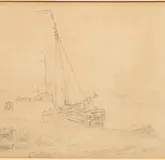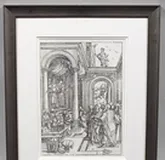
Файнингер: деревенская церковь и колокольня

Описание
(1871 г. Нью-Йорк - 1956 г. там же) Деревенский вид с церковью в июле 1926 года, скорее всего, в окрестностях Веймара, исследование Файнингера, в чьем творчестве церкви и колокольни играют важную роль как в его картинах и рисунках, так и в акварелях и графике. Особенно форма высоких, заостренных, игольчатых колокольни, например, вдохновленная Гельмеродой, привела его к созданию кристаллических композиций. В 1919 году Файнингер немедленно был назначен первым мастером Баухауса Уолтером Гропиусом после основания Государственного Баухауса в Веймаре, где он жил до 1926 года и также руководил печатными мастерскими до 1925 года. 30 июля 1926 года Файнингер с семьей переехал в один из недавно построенных мастерских домов в Дессау, хотя он официально оставался "мастером" в Баухаусе до 1932 года, его освободили от всех преподавательских обязанностей. После принудительного закрытия Дессауского Баухауса в 1932 году Файнингер переехал в Берлин, а в 1937 году окончательно вернулся в США. Во время национал-социализма работы Файнингера официально считались "дегенеративным искусством", и 378 работ художника были изъяты из публичных коллекций. Карандаш на клетчатой бумаге с двойным отверстием. Надпись сверху "15(.)7(.)19)26". Размеры: 22.5 см x 14.5 см. В раме. Происхождение: Из коллекции Лоренса Файнингера (1909-1976), сына художника.
Похожие лоты

Лот № 14605 Картины
Мулен де Галетта: в…
Морис Утрилло

Лот № 14640 Картины
Студии фигур
Генрих Цилле

Лот № 14592 Картины
"Шеле: редкий орнам…
Курт Шеле

Лот № 14170 Картины
Миддельбург - Клеве…
Баренд Корнелис Кук…

Лот № 14077 Картины
"Медный гравюра Бра…
Неизвестный Автор

Лот № 14062 Картины
"Прогулка Марии в х…
Альбрехт Дюрер

Лот № 14078 Картины
"Три виды медных гр…
Неизвестный Автор

Лот № 14639 Картины
"Радебург - Берлин:…
Генрих Цилле

Лот № 12423 Марки , открытки
Перевод по Телеграф…
Открытки
★★★47

Лот № 12426 Марки , открытки
КОНВЕРТ. КРАСНЫЙ КР…
Открытки